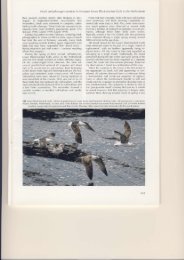Identification of American Herring Gull in a western European context
Identification of American Herring Gull in a western European context
Identification of American Herring Gull in a western European context
Create successful ePaper yourself
Turn your PDF publications into a flip-book with our unique Google optimized e-Paper software.
<strong>Identification</strong> <strong>of</strong> <strong>American</strong> <strong>Herr<strong>in</strong>g</strong> <strong>Gull</strong> <strong>in</strong> a <strong>western</strong> <strong>European</strong> <strong>context</strong>that case, be less <strong>in</strong>cl<strong>in</strong>ed to show a complete blackband on p5, and may have darker grey upperparts.While the primary pattern <strong>in</strong> third-w<strong>in</strong>ter birds is acomplex character (eg, also because <strong>in</strong>tergrades argenteusx argentatus have to be taken <strong>in</strong>to account), it maybe worth look<strong>in</strong>g at and document<strong>in</strong>g when faced witha suspected third-w<strong>in</strong>ter smithsonianus <strong>in</strong> Europe.We would like to emphasize that some thirdw<strong>in</strong>tersmithsonianus can appear very similar tosecond-w<strong>in</strong>ter <strong>European</strong> <strong>Herr<strong>in</strong>g</strong> <strong>Gull</strong>. The problem/pitfallmay be as follows: an observer mayencounter a <strong>Herr<strong>in</strong>g</strong> <strong>Gull</strong> that attracts his attentionbecause <strong>of</strong> its dark underparts and h<strong>in</strong>dneck,dark greater coverts and tertials, a lot <strong>of</strong> dark <strong>in</strong>the tail, contrast<strong>in</strong>gly pale grey saddle, etc. Hemay be tempted to believe that he is look<strong>in</strong>g at asecond-w<strong>in</strong>ter smithsonianus, but when he looksmore closely, the tail is certa<strong>in</strong>ly not all-dark,and the upper- and undertail-coverts are hardlymarked at all. Therefore, he dismisses the bird asan odd (dark) second-w<strong>in</strong>ter <strong>European</strong> <strong>Herr<strong>in</strong>g</strong><strong>Gull</strong> – while <strong>in</strong> fact, it was a perfectly typicalthird-w<strong>in</strong>ter smithsonianus... Correct age<strong>in</strong>g is acritical first step <strong>in</strong> the identification process, but<strong>in</strong> third-w<strong>in</strong>ter birds, it may at times only be possiblewhen the bird is seen <strong>in</strong> flight (when the<strong>in</strong>ner primaries can be seen).Fourth-w<strong>in</strong>ter and older (plate 73-85, figure 3)A surpris<strong>in</strong>gly high proportion <strong>of</strong> the essentiallyadult-like smithsonianus we observed <strong>in</strong> Massachusetts<strong>in</strong> January-February exhibited features<strong>in</strong>dicative <strong>of</strong> immaturity such as dark mark<strong>in</strong>gson the bill, dark-centred primary coverts or darkspots on the secondaries, tertials and rectrices.One explanation for the comparative abundance<strong>of</strong> ‘near-adult’ types amongst the birds westudied <strong>in</strong> Massachusetts might be that, for somereason, this is a preferred w<strong>in</strong>ter<strong>in</strong>g area for fourt<strong>of</strong>ive-year-old birds. The high proportion <strong>of</strong>‘near-adult’ types might also <strong>in</strong>dicate that smithsonianus,on average, takes significantly longerto acquire a fully adult appearance (without vestiges<strong>of</strong> immaturity) than does <strong>European</strong> <strong>Herr<strong>in</strong>g</strong><strong>Gull</strong>. Whatever the reason, we have no way <strong>of</strong>know<strong>in</strong>g the precise age <strong>of</strong> these birds but, <strong>in</strong>view <strong>of</strong> their overall similarity to adults, we assumethat most are at least <strong>in</strong> their fourth w<strong>in</strong>terand we prefer, therefore, to <strong>in</strong>clude them <strong>in</strong> an‘adult-type’ category. At present, these <strong>in</strong>dividualsexhibit<strong>in</strong>g certa<strong>in</strong> characteristic vestiges <strong>of</strong>immaturity <strong>in</strong> comb<strong>in</strong>ation with an otherwiseessentially adult-like appearance may be theonly adult-type smithsonianus that can be conclusivelyidentified <strong>in</strong> Europe.There has been some suggestion that adultsmithsonianus have paler upperparts than argenteus.Never hav<strong>in</strong>g had a chance to compareadult smithsonianus directly with <strong>European</strong><strong>Herr<strong>in</strong>g</strong> <strong>Gull</strong>s, it is difficult to evaluate the practicalusefulness <strong>of</strong> this feature <strong>in</strong> the field. Ingeneral, the upperparts <strong>of</strong> smithsonianus are palegrey (Kodak grey scale 4.0-4.5), similar <strong>in</strong> tone toargenteus and R<strong>in</strong>g-billed <strong>Gull</strong> and clearly palerthan mean argentatus (Howell & Elliott 2001).However, we did note some variation <strong>in</strong> upperpartcolouration, even <strong>in</strong> small groups <strong>of</strong> birds,with a few <strong>in</strong>dividuals slightly darker than themajority. The paleness <strong>of</strong> the upperparts <strong>in</strong> manysmithsonianus may, however, be <strong>of</strong> greater significancewhen compared with argentatus.The follow<strong>in</strong>g features may be <strong>of</strong> more practicaluse <strong>in</strong> identification <strong>of</strong> near-adult and adultsmithsonianus.Tertial-spots One feature that was a surprise to us wasthe presence <strong>in</strong> a small percentage (5-10%) <strong>of</strong> nearadults(and possibly a few adults?) <strong>of</strong> discrete black‘<strong>in</strong>k-spots’ on one or more <strong>of</strong> the tertials (plate 75, 76and 79, figure 3). These spots appear to be l<strong>in</strong>ked tothe extensive dark mark<strong>in</strong>gs shown by many third-w<strong>in</strong>ters,and are similar <strong>in</strong> extent to the dark spots exhibitedby some second-w<strong>in</strong>ter Common L canus canus andR<strong>in</strong>g-billed <strong>Gull</strong>s. They can, at times, be hidden by theoverly<strong>in</strong>g tertial(s) and may only become visible if thefeathers are displaced by w<strong>in</strong>d or while preen<strong>in</strong>g. Inother <strong>in</strong>dividuals, they are extensive and can form aregular ‘stepp<strong>in</strong>g stone-like’ pattern across the tertials.While this pattern is usually associated with othertraces <strong>of</strong> immaturity, such as a band on the bill or darkcentredprimary coverts, a few apparently ‘perfect’adults may show one or two small black tertial-spots(plate 75). We have never observed equivalent mark<strong>in</strong>gs<strong>in</strong> adult or near-adult <strong>European</strong> <strong>Herr<strong>in</strong>g</strong> <strong>Gull</strong>s althoughit appears that similar mark<strong>in</strong>gs may occur <strong>in</strong>some forms <strong>of</strong> Yellow-legged <strong>Gull</strong> L michahellis (plate22 <strong>in</strong> Dubois 2001, pers obs). We recommend that any‘light-mantled’ herr<strong>in</strong>g gull <strong>in</strong> Europe exhibit<strong>in</strong>g thischaracter should certa<strong>in</strong>ly receive detailed scrut<strong>in</strong>y.Secondary-spots Occasional <strong>in</strong>dividuals <strong>in</strong> this agecategory show small, well-def<strong>in</strong>ed black spots onotherwise adult-like secondaries (plate 80 and 82). Thisfeature is much more likely to be detected <strong>in</strong> photographsthan <strong>in</strong> the field but, when present, may be adiagnostic <strong>in</strong>dicator <strong>of</strong> smithsonianus.W<strong>in</strong>g-tip pattern Attention has been drawn to a potentialdifference <strong>in</strong> w<strong>in</strong>g-tip pattern between smithsonianusand <strong>European</strong> <strong>Herr<strong>in</strong>g</strong> <strong>Gull</strong>s (Mill<strong>in</strong>gton & Garner1998), with at least some birds, apparently orig<strong>in</strong>at<strong>in</strong>g<strong>in</strong> north-eastern Canada, hav<strong>in</strong>g paler and longer greytongues along the <strong>in</strong>ner web <strong>of</strong> the outer primaries than<strong>in</strong> typical argenteus (but not unlike some argentatus).W<strong>in</strong>g-tip pattern <strong>of</strong> smithsonianus is known to be variable:Jonsson & Mactavish (2001) described significant27










